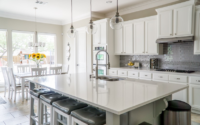How to Design a Low-Maintenance Landscape for Your Home

Designing a beautiful and functional landscape for your home can be a rewarding experience, but it can also be a lot of work to maintain. If you’re looking for a way to enjoy a stunning outdoor space without spending all your free time on upkeep, consider designing a low-maintenance landscape. Here are some tips to get you started:
Choose the right plants
The first step to designing a low-maintenance landscape is to choose the right plants. Look for plants that are native to your area and are adapted to the local climate and soil conditions. These plants will require less water and fertilizer than exotic species, and they will be more resistant to pests and diseases.
You should also choose plants that are well-suited to the amount of sunlight and moisture in your yard. If you have a shady area, look for shade-loving plants like ferns, hostas, and hydrangeas. If you have a sunny area, choose plants like succulents, lavender, and ornamental grasses that thrive in hot, dry conditions.
Use mulch
One of the easiest ways to reduce maintenance in your landscape is to use mulch. Mulch helps to retain moisture in the soil, which means you’ll need to water your plants less frequently. It also helps to suppress weeds, which means you’ll spend less time pulling them.
There are many different types of mulch to choose from, including wood chips, shredded leaves, and straw. Choose a mulch that complements the style of your landscape and that is easy to source in your area.
Consider hardscaping
Hardscaping refers to the use of hard materials like stone, brick, and concrete in your landscape design. Incorporating hardscaping elements like patios, walkways, and retaining walls can help to reduce maintenance by providing durable, long-lasting surfaces that require little upkeep.
In addition to being low-maintenance, hardscaping can also add visual interest and contrast to your landscape. Consider using a variety of textures and colors to create a cohesive design.
Plan for irrigation
Proper irrigation is essential for the health of your plants, but it can also be a time-consuming task. To reduce maintenance, consider installing an irrigation system that will water your plants automatically.
There are many different types of irrigation systems to choose from, including drip irrigation, sprinklers, and soaker hoses. Choose a system that is appropriate for the size and shape of your yard, and that is easy to adjust and maintain.
Keep it simple
Finally, one of the best ways to create a low-maintenance landscape is to keep it simple. Avoid using too many plants or features that require a lot of upkeep. Instead, focus on a few key elements that will create a beautiful and functional space.
For example, you might choose a few low-maintenance plants, a simple hardscaping element like a patio, and a few decorative features like a birdbath or a garden statue. By keeping your design simple and streamlined, you’ll be able to enjoy your outdoor space without spending all your time maintaining it.
In conclusion, designing a low-maintenance landscape for your home is all about choosing the right plants, using mulch, incorporating hardscaping, planning for irrigation, and keeping it simple. By following these tips, you can create a beautiful outdoor space that requires minimal upkeep, leaving you more time to relax and enjoy your yard.


